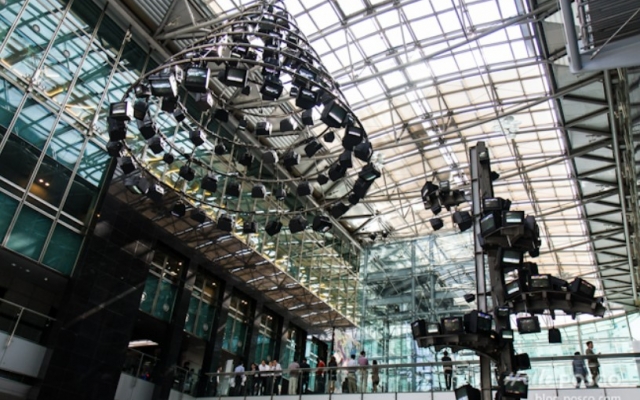Seeing large-scaled art pieces in the lobbies of company buildings is pretty common these days. More and more companies are bringing artworks into their buildings because art can make a gathering space interactive, reflect the company’s identity as an innovative and sophisticated brand, and contribute to society by opening their art collections to the public.
For various reasons, many companies have been entering the art world, building art collections at a size that is comparable to museums. Here are three South Korean corporates that have also participated in this trend, providing the public with an opportunity to enjoy art with their art collection.
 Installation view of Do Ho Suh's Cause and Effect at HITE Collection, Seoul ⓒ Do Ho Suh & HITE Collection.
Installation view of Do Ho Suh's Cause and Effect at HITE Collection, Seoul ⓒ Do Ho Suh & HITE Collection.Hite Collection – HiteJinro Co., Ltd.
HiteJinro Co., Ltd. is a drink, brewing, and distiller company based in South Korea. The Hite Cultural Foundation opened an exhibition space on the two lower floors of HiteJinro’s headquarters in 2010.
With the mission of contributing to society by opening its contemporary art collections to the public, the Hite Collection has been supporting the artistic practices of contemporary artists and enhancing the public’s understanding of contemporary art by holding various exhibitions.
The Hite Collection is known for having the most extensive collection—about 120 artworks—of Kwon Jinkyu, one of the most important sculptors in Korea’s modern art history. It is also known for having Do Ho Suh’s Cause & Effect, an eight-meter-high installation work hanging from the lobby ceiling on the first floor to the lower level.
The Hite Collection, consisting of artworks by Korean and international artists, aims to reflect the contemporary art world in various aspects through its exhibitions.
The Hite Collection will be holding a group exhibition entitled Kak from May 28 to July 17, 2022. Kak aims to question “the meaning of sculpture in contemporary art” through artworks by twelve contemporary artists, including Lee Bul (b. 1964), Do Ho Suh (b. 1962), Gwon Osang (b. 1974), Lim Jeong soo (b. 1988), and Cha Sla (b. 1989).
 The view of Alexander Liberman’s 'Archway' at the Main building and Water Garden of Museum SAN. Wonju, Gangwon.
The view of Alexander Liberman’s 'Archway' at the Main building and Water Garden of Museum SAN. Wonju, Gangwon.ⓒ Alexander Liberman & Museum SAN
Hansol Group Collection – Museum SAN
Museum SAN (Space, Art, and Nature) is located in a vast mountain range in Wonju, Gangwon province. It was founded by the Hansol Cultural Foundation, an affiliated organization of Hansol Group, which owns Korea’s largest paper production firm.
The foundation’s collection started as the private collection of Lee In-hee, the Samsung founder’s eldest daughter and adviser to Hansol Group. Lee was known as one of the leading women art collectors in Korea. In 2005, Lee began to work with the Hansol Cultural Foundation to open the Hansol Museum, which eventually opened in 2013 as a 73,000 square meter site with 4,000 works of papercraft and modern and contemporary artworks. The Hansol Museum changed its name to Museum SAN in 2014.
One of the best-known artworks from the foundation’s collection is Alexander Liberman’s Archway, built over the main building’s entrance pathway. The meditative buildings and structures are also known for being designed for eight years by the world-renowned architect Tadao Ando.
The foundation’s collection is known for having a variety of works from modern and contemporary art, design, and architecture, as well as a large number of traditional papercrafts. The collection includes works from many modern Korean masters, such as Park Soo Keun, Lee Jung Seob, Kim Whanki, and Lee Quede. The works of contemporary artists are mainly introduced through special exhibitions at the Cheonjo Gallery, the art museum of Museum SAN.
Museum SAN aims to introduce the art of high standards, which can reflect and lead to a greater appreciation of Korean modern and contemporary art.

Installation view of Name June Paik's 'Cheori Cheolcheol-TV Chandelier, TV Tree' (1995) at POSCO Center, Seoul ⓒ Nam June Paik & POSCO.
POSCO Collection – POSCO Center & POSCO Art Museum
POSCO, a South Korean steel-making company, has been actively collecting artworks since 1995, especially after it opened its headquarters in Gangnam, Seoul, with a plan to have an art museum on the lower level. The company’s collection reportedly has around 1,150 artworks by six hundred Korean and international artists.
Before its opening in 1995, the POSCO Center received significant attention from the Korean art world as they announced that the building would have around fifty artworks that fit into the cutting-edge structure and reflect the company’s characteristics. The POSCO Center currently has fourteen large-scale works that reflect the steel company’s identity on view inside and outside its building.
In front of the center is Frank Stella’s Flowering Structure: Amabel (1997), known for being purchased for $1.4 million in 1997. Nam June Paik’s Cheori Cheolcheol-TV Chandelier, TV Tree (1995), and Lee Ufan’s Relatum (1995) are also some of the best-known artworks in the collection.
POSCO Art Museum, which opened as a gallery in 1995 and became an art museum in 1998, aims to become an accessible open space for the public to foster interaction and communication through art.








